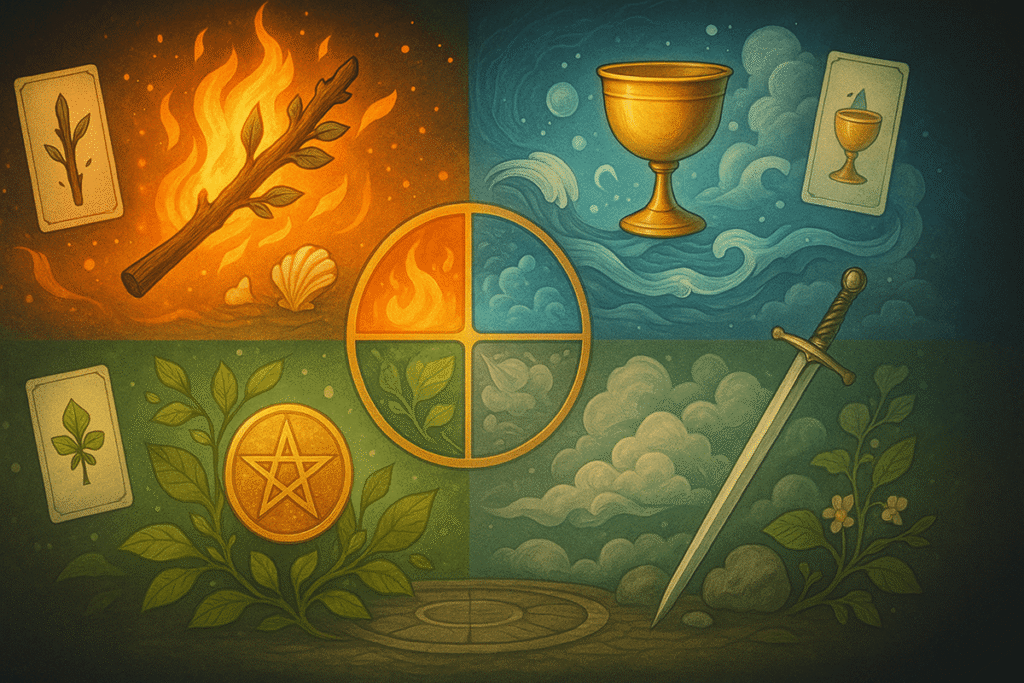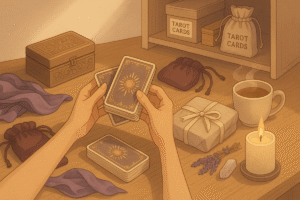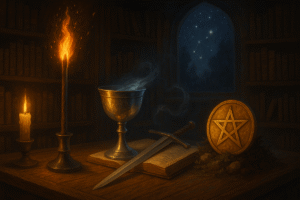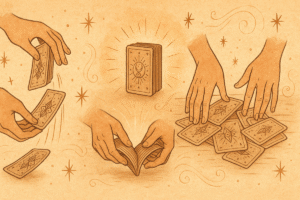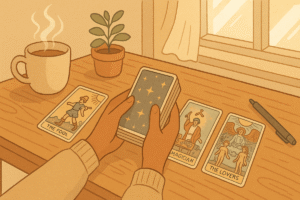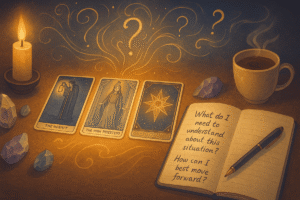Table of Contents
When you first pick up a tarot deck, the sheer number of cards can feel overwhelming. Seventy-eight images, each supposedly holding meaning and insight. But here’s something I find helpful: the deck isn’t just a random collection. It’s organized, and understanding that organization changes everything about how you experience the cards.
The four suits of the Minor Arcana each carry a distinct energy, a particular feeling that you can learn to recognize. And these feelings aren’t arbitrary. They’re rooted in the classical elements: fire, water, air, and earth. Once you start noticing the elemental quality of each suit, the cards begin to speak in a language that goes beyond memorized keywords.
Understanding the Elemental Framework
The connection between tarot suits and elements is ancient, though perhaps not as old as tarot itself. Over centuries of use, practitioners observed patterns. Wands cards felt different from Cups cards. Swords had a sharpness that Pentacles lacked. These observations eventually crystallized into a system linking each suit to one of the four classical elements.
This isn’t about rigid rules. It’s more like… have you ever walked into a room and immediately sensed the mood? That’s closer to what we’re talking about. Each suit has an atmosphere, a texture that you can learn to feel when you encounter it in a reading.
I think this elemental approach offers something valuable for reflection. Instead of asking “What does this card predict?” you might ask “What energy am I being invited to notice right now?” It shifts the entire experience from fortune telling to self-inquiry.
Wands and the Element of Fire
Let me start with Wands because fire is perhaps the easiest element to grasp viscerally. Fire moves. It consumes, transforms, and radiates energy outward. When Wands appear in your reading, you’re in the realm of action, passion, and creative drive.
Think about how fire behaves. It doesn’t sit still. It reaches upward, spreading if given the chance, dancing with an almost eager quality. Wands cards carry this same restless energy. They ask you to consider where you’re feeling motivated, where your enthusiasm lives, what projects or ideas are calling for your attention.
The suit of Wands invites questions like: What am I passionate about right now? Where do I feel most alive and energized? What creative impulses am I experiencing?
But fire has another quality too. It can burn out if there’s nothing to sustain it. It can become destructive if uncontrolled. So Wands also prompt reflection on whether you’re channeling your energy sustainably or perhaps scattering it too widely. Are you burning with purpose or just burning yourself out?
When I see multiple Wands in a spread, I notice an atmosphere of movement and possibility. Things feel dynamic, maybe even a bit chaotic. There’s momentum, though perhaps not always clear direction. The energy wants to go somewhere, to manifest, to create change in the tangible world.
Cups and the Element of Water
Cups take us into completely different territory. If Wands are about action and drive, Cups are about feeling and connection. The element of water flows, adapts, and reflects. It fills whatever container holds it, finding its way into every crack and crevice.
Water is the element of emotion, intuition, and relationships. It’s about what moves beneath the surface, the currents we can’t always see but definitely feel. Cups cards invite you to explore your emotional landscape, to notice what you’re feeling and how you’re connecting with others.
The questions Cups might prompt include: How am I feeling about this situation? What emotional needs are present? How are my relationships affecting me? What does my intuition suggest?
There’s a receptivity to Cups that contrasts sharply with Wands’ active pushing forward. Water receives. It responds. It reflects back what’s around it. When Cups appear, you might consider what you’re absorbing from your environment, what emotional patterns you’re swimming in, perhaps even what you need to release or let flow away.
Water can be still and peaceful, like a calm lake. But it can also be turbulent, overwhelming, even drowning. The Cups suit holds this full spectrum of emotional experience, from joy and love to sadness and loss. It acknowledges that feelings aren’t always comfortable, but they are real and deserve attention.
I find that Cups-heavy readings often feel gentler somehow, even when the specific cards might be challenging. There’s an invitation to be with your feelings rather than immediately acting on them, to let things settle before deciding what to do next.
Swords and the Element of Air
Now we come to Swords, and here the energy shifts again. Air is the element of thought, communication, and mental clarity. It’s invisible but powerful. You can’t see wind, but you certainly feel its effects.
Swords cut through confusion. They separate truth from illusion, fact from fiction. This suit lives in the realm of logic, analysis, and honest communication. When Swords appear, you’re being asked to think clearly, to examine your beliefs, to perhaps cut away what no longer serves your understanding.
The reflective questions Swords inspire might include: What do I actually think about this, separate from what I feel? What truth am I avoiding? What needs to be communicated clearly? Where is my thinking clouded or confused?
Air has a quality of detachment. It observes without getting entangled. This can be incredibly useful when you need perspective, when emotions are running too high to see clearly. Swords offer that step back, that breath of fresh air that lets you assess a situation more objectively.
But here’s where Swords get their difficult reputation. Cutting can be painful. Truth can hurt. The clarity that Swords offer isn’t always comfortable. Sometimes seeing things clearly means recognizing uncomfortable realities about ourselves or our situations.
I notice that people often have complicated relationships with Swords cards. The imagery is sharp, sometimes violent. Yet I think there’s something valuable in this suit’s refusal to sugarcoat or avoid difficult realities. Swords ask for intellectual honesty, even when that honesty is challenging.
Pentacles and the Element of Earth
Finally, we have Pentacles, grounded in the element of earth. If the other three elements have a certain ethereal or energetic quality, earth is solid, tangible, real. You can touch earth. You can build on it. It’s where everything else ultimately manifests in physical form.
Pentacles concern themselves with the material world: resources, work, health, home, security. This is the suit of practical matters, of what you can see and hold and measure. It’s perhaps the most literal of the four suits in some ways.
The questions Pentacles might raise include: What resources do I have available? What am I building or creating in the physical world? How secure do I feel? What does my body need? How am I relating to material concerns?
Earth is patient. It doesn’t rush. Growth in the earth element happens slowly, with consistent effort over time. A seed becomes a plant becomes a harvest, but not overnight. Pentacles carry this energy of steady development, of tending to what matters, of showing up day after day to do the work.
There’s a stability to earth that can feel reassuring, especially if the other elements in a reading feel chaotic. Pentacles remind you that some things require patience, that not everything needs to happen immediately, that building something lasting takes time and sustained attention.
But earth can also be stubborn, resistant to change. Pentacles sometimes highlight where you might be stuck in material concerns, overly focused on security to the exclusion of other needs, or perhaps taking the practical world so seriously that you forget to play.
Feeling the Elements in Practice
Understanding these elemental associations intellectually is one thing. Actually feeling them in your readings is another entirely. I think this comes with practice and attention.
Try this as an experiment: pull out all the cards from one suit. Lay them out and just look at them for a while. Notice the imagery, the colors, the symbols. How does this collection feel as a whole? What mood or energy do you sense?
Then do the same with another suit. Can you feel the difference? The contrast between Cups and Swords, for instance, becomes quite vivid when you look at them side by side.
You might also notice how the elements interact in a reading. Fire and air can fuel each other; think of how wind makes flames burn hotter. But water can extinguish fire, just as earth can smother it. These elemental relationships add another layer of insight when you’re reflecting on how different energies in your life might be supporting or conflicting with each other.
Moving Beyond Keywords
Here’s what I’ve found most valuable about the elemental approach: it frees you from depending entirely on memorized meanings. If you know a card is a Sword, you know you’re in the territory of air, of thought and communication. Even if you can’t remember the specific traditional interpretation, you have a felt sense of the card’s domain.
This becomes especially helpful with cards that don’t have immediately obvious imagery or that seem to contradict their traditional meanings in a particular reading. The elemental quality gives you a foundation to work from, a starting point for reflection.
The four tarot suits elements create a framework that’s flexible enough to accommodate personal interpretation while structured enough to provide guidance. You’re not making things up randomly, but you’re also not locked into rigid definitions that might not fit your specific situation.
Bringing It All Together
Learning to feel the elements in your tarot practice changes how you interact with the cards. Instead of hunting for predictions or definitive answers, you start noticing energies and asking better questions.
Where do you need more fire, more passion and drive? Where might you benefit from water’s emotional wisdom? When would the clarity of air serve you well? What requires earth’s patient, steady attention?
These aren’t questions with simple answers. They’re invitations to explore, to notice, to become more aware of the different qualities of energy moving through your life. And perhaps that’s exactly what makes this approach so valuable for personal reflection and growth.
The elements offer a language for something we often struggle to articulate: the texture of our inner experience, the shifting dynamics of how we engage with the world. Through Wands, Cups, Swords, and Pentacles, we have four distinct lenses for examining our lives, four different ways of understanding what we might need or what we might be overlooking.

